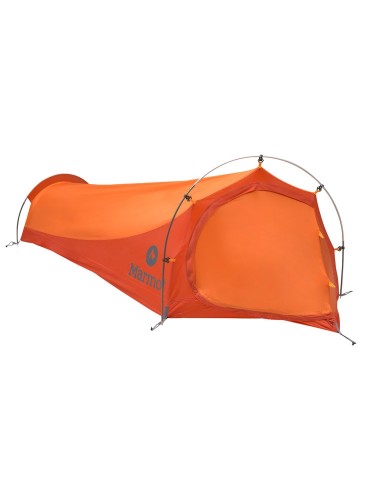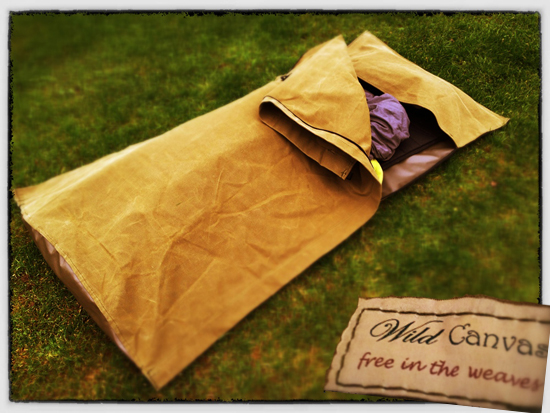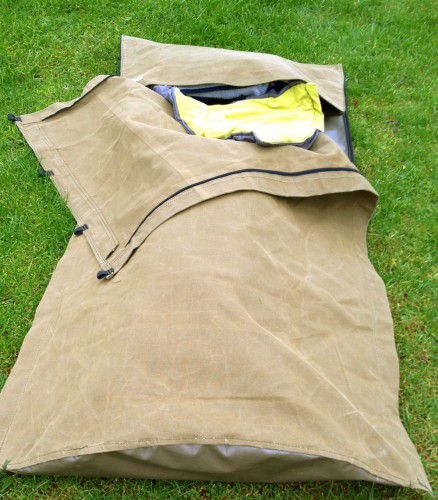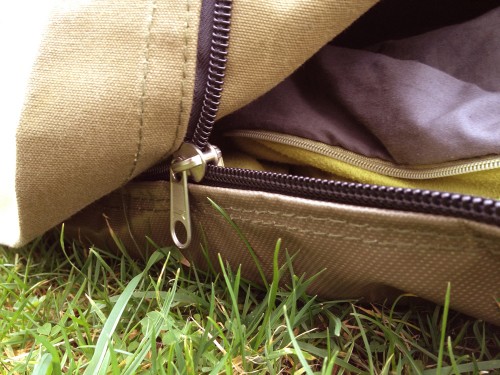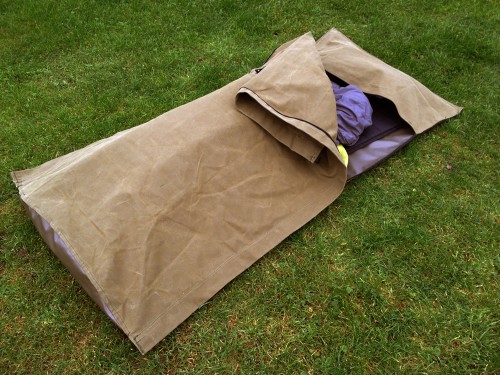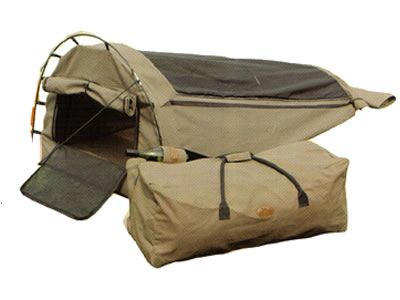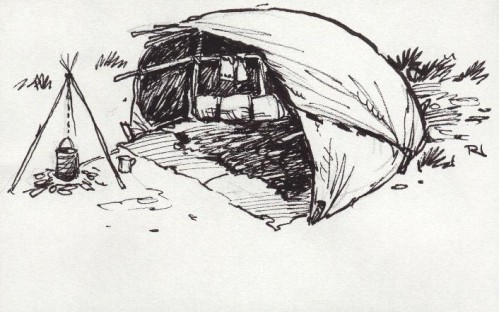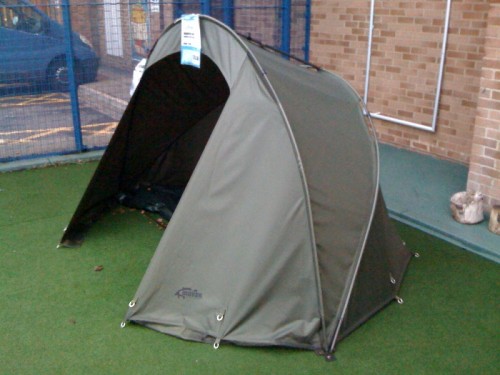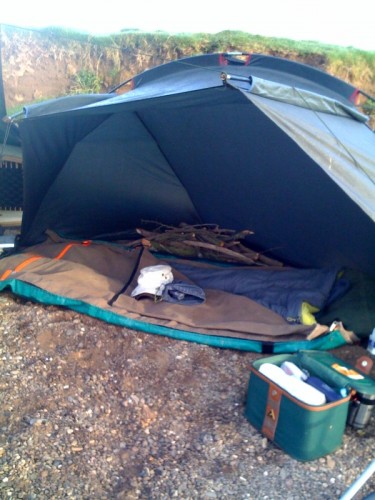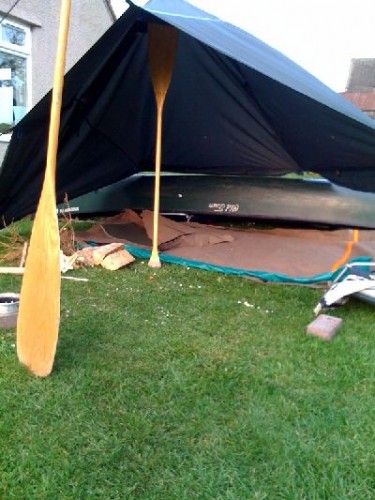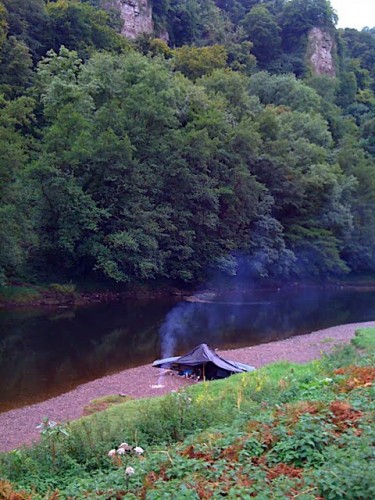There’s a lot of choices for bivvy bags and one-man ultralight tents. With these you do have the condensation issues, the often garish colours (fine for Mountaineering of course), and the delicate materials than can easily get snagged or get spark holes and tend to flap around in the wind, but there are still some nice designs around. This one from Marmot is quite a clever design, although the day-glo colour is not for me, but looks like some real thought has gone in to it:
Category Archives: Tents
The Wynnchester Australian Swag Bedroll
Great news for anyone interested in trying swag camping: As part of our “Wynnchester Camp & Adventure” project to bring back robust traditionally-inspired canvas camp gear we’ve been working with a small UK manufacturer on our own design of Australian-style canvas swag bedrolls right here in the U.K. [Edit: we’re no longer working with “Wild Canvas” for this project due to various issues and have a new UK supplier]. Previously the only option was to buy from Australia with shipping costs often being more than the cost of the swag! To my knowledge they are the only Australian swag bedrolls being made in Europe. They are available now to buy online from www.wynnchester.co.uk.
So: After a year of design and planning I’ve just had the first batch of the product through, and I have to say it is truly a thing of beauty! Have a look at the pictures below and see what you think.
Based on many years of swag camping in different types of australian swags, for different purposes, 4×4 trips, canoe trips, car-camping and family camps, and in different environments: from the Australian desert to the British winter, at designated camp sites, or wild camps in woodland, mountainsides, beach camping and on river banks and lake shores, we’ve been able to design this one from the ground up, with some new features based on real-world use, and also we’ve avoided too many unnecessary features, velcro, guy ropes, or bright colours which many modern australian swags suffer from – this is true to the traditional swag in design and purpose and also I think it is a thing of beauty that you can cherish and get many years of use from, hopefully taking you to some wild places and enabling you to experience wild camping at it’s best, and at it’s simplest. Here’s some of the design and manufacturing features:
- Tough, waterproof and beautiful high quality 18oz canvas – in khaki and green natural colours
- Tough waterproof PVC base – again sourced in natural khaki colour rather than the often garish bright colours PVC often comes in.
- Full-length, heavyweight zips – on both sides so you can enter and exit either side away from the wind, towards your campfire etc.
- Pillow pocket to stuff your clothes, valuables, torch etc. in during the night
- The design is made to form a natural dome shape over you when inside to shed rain
- Storm flap which folds down blanket-style for good weather, meaning you can sleep open to the stars when the weather permits, and even if it changes during the night you can just pull the storm flap over and run the zips up past your head for more protection from wind and rain in the weather turns. Or add one or two poles to give extra internal space and further help to shed rain. Making the change easily without getting out in the middle of the night is very useful, unlike some swags.
- Tough enough to walk on and sit on around camp or to unpack or sort your gear whilst it protects your sleeping bag etc. from mud, damp and dirt around camp.
- Elipse-shaped foot section
- Again the design is specifically worked out so that unlike a lot of Australian swags with boxed sections and hoods etc. this one will fold very flat meaning it rolls up into a much smaller package for travel and storage.
- Webbing loops for attaching paracord to
- Large size fits a 6-footer plus – one of the great things about swags is they are naturally roomy inside, allowing you to move around comfortably in your sleeping bag or just using blankets.
- A hoop seam for fitting the aluminium pole kit if required.
- Can be used with any type of mattress or none (if camping on sand for example) – thermarest, small air mattress, foam camping mattress or the army type roll matt.
- Rolls up very small compared to other swags, with carry handle and buckle clips.
- no guy ropes or pegs needed
If you’re wondering what the fuss is about, see our full posts on swag camping for more info on this great way to get out in nature. The swags are on sale at www.wynnchester.co.uk. The price is not cheap but remember these will last a long time, putting up with rough treatment and sparks from a campfire. Then there’s the quality: the canvas is very tough 18oz weight and the very best money can buy, very hard to get hold of in fact, and that these swags are hand-made by specialists.
Compare this also with what’s available that is similar such as the Duluth Bedroll in the USA at 180 US dollars or the cost of buying a swag direct from Oz coming in at around the £200 mark just for the shipping! So yes it’s not a cheap throwaway item, but I can say from experience that even one amazing night out under the stars in some remote (or even not so remote) location and it will be well worth the investment. Knowing you can do that again in other places, whenever you want, as they say at Mastercard “priceless”.
OK here’s the pics: (click for full size images: note the colours are not exactly right in these pictures, the canvas is more of a green khaki than this brown – I’ll get more pics as soon as I have them).
The swag rolled up with carry handle – the rolled up swag measures about 60cms long by about 25cms width:

The storm flap open for good weather and easy access: this pic also shows the elipsed foot section and the natural dome shape that helps to shed rain.
The heavy duty zips with snug overlap where the canvas joins the PVC:
Photos showing thermarest self-inflating mattress and sleeping bag arrangement, with the pillow pocket and storm flap:
The full Wynnchester canvas bedroll/swag – simple, elegant and above all TOUGH as nails!:
[Update: there are new photos of the latest model in a darker green khaki colour with twin pre-curved aluminium poles on the website at www.wynnchester.co.uk. ]
Luxury Swag! Australian style outdoors comfort…
[Update: new Wynnchester Canvas Australian Swags will soon be available to buy online – see latest post.
Australia is the home of the canvas “swag” of course, and the best place to look out for the range of different styles and prices available down under is the Australian Ebay site. This one above from Ebay is the height of luxury in a swag: a one person canvas hotel room! It’s an an Onland Woodland CDK Canvas KING SIZE Dome Swag with FREE bag & Stubby Holder! An extensive set of features includes:
- Fibreglass poles at head,centre and foot for easy entry and comfortable space
- Heavy duty PVC waterproofed base
- External window with roll up flap
- Zippered mozzie net in top section for ventilation
- Made from 14oz waterproofed cotton canvas
- Stainless steel “D” rings
- Heavy duty #10 coil zip
- 2″ High density foam mattress with removable cotton cover
Now that’s luxury 😉 Here’s the Ebay link – worth a look at some of the other Australian swags for sale on there too.
Baker Tent Hunt – the half-dome shelter
In addition to the full size campfire tent and lightweight versions we’ve looked at, one of the simplest ways to achieve a ‘campfire tent’ setup would be the ‘half dome shelter’.
Source: Period Shelters -http://poisonriverparty.homestead.com/Shelters.html
In fact this construct was used widely in woodland camping by the North Eastern native American populations. One such construction was shown in Ray Mears series on “Rogers Rangers” an exploration of how WIlliam Rogers led expeditions and raiding parties in the early british military campaigns in the Frontier country with Canada, fighting both the French and the opposing native tribes. The demonstration by a descendent of the local tribes showed how a half dome shelter would be built. Interestingly the structure of the frame would be made at the camp site, from materials found thereabouts, whilst the covering was made from wide sheets of birchbark, which being the most valuable material as well as extremely lightweight, would be carried from camp to camp – a new frame simply being built as required at the next location.
Ray shows how with a fire built out front the shelter is extremely insulating, and practical allowing easy access in and out, and the ability to cook under cover using the fire in front of the shelter. These are all characteristics of the “Campfire Tent” or “Baker Tent” we were looking for.
That episode showed a beautiful end result of this technique – I am keen to try this technique, but using a tarp instead of birchbark.
So in searching for a modern version of this ‘half-dome campfire tent’ i began looking into surprisingly fishing “bivvies” which typically do have this half dome shape, as well as a rigid or semi-rigid frame built in. There are many types of these bivvies on the market, with the key differentiating from our point of view being weight and b8ulk, as we will want to carry this in a canoe, as well as portaging where necessary.
So clearly some of the larger more heavy duty fishing shelters, or “carp bivvies” or “brollys” as they are also known in the world of course fishing are not suitable in this case. The most interesting I found were these two:
The Fox Evolution XS Shelter/Bivvi.
This has a rigid, interlocking hooped frame which interestingly stays in place when the shelter is collapsed, making setting up and taking down very quick and simple, as well as great resistance against the wind. Also importantly this one can be set lower in bad weather, another feature of Bill Mason’s campfire tents – that of being highly adjustable to the weather conditions. Here’s a pic:
(a good review here) The downside of course here is that its still quite heavy at 4.2kg (if you compare to a tarp/pole/line setup), but even more importantly its bulky at 1.9m long (!) and 11cm’s diameter size when packed.
All the fishing bivvi info you’ll ever need is here at http://www.bivvies.co.uk/
The Wychwood Rogue Shelter.
This is the most lightweight of the bivvi shelters, with simple shock-corded poles in place of more rigid frames, but again the ability to change the shape significantly from wide open and high at the front very low and enclosed in bad weather. The shelter is extremely lightweight, has good fixings and guy ropes and is very easy to put up (once you’ve tried a few times – at first its quite confusing!). So this one really began to get our attention and we purchase one on Ebay for an incredibly cheap price of just £25, compared to the normal price of about £48. It was a brand new and unpacked one…and in fact the chap who sent it out actually sent out 5 in one box not realising it was a group – I let him know and he arrnged for the others to be picked up – we’re an honest lot here.
So the Wychwood shelter in backyard and canoe trip test turned out be absolutely excellent – the only downside that the poles although light, because they aren’t designed for canoe camping as such are quite long at about 5 foot, rather than being made up of shorter sections- and that does make it a bit big or rather long in the boat, although its no real problem.
The Shelter when set up really does make exactly the half-dome ‘campfire tent’ shelter we were after, and even looks very much like the native american shelters that inspired the idea. It’s a fantastic shape and has only one downside I can see – which is faced into strong winds it can take quite a bashing and become unstable – but if you’re on good ground for pegging this hasn’t been a problem for me even in extreme conditions, lowering the front egde means you can position it carefully in the wind, to get some downforce in play as well.
On less good ground for pegs it can be more of an issue. And in fact on a winter camp last year what were the most violent gusts of winds I’ve ever experienced anywhere on 3 continents hit our camp for a short while, probably half an hour only. Fortunately the direction was favourable, as the shelter got buffeted in the back edge forcing the structure down rather than taking it skyward! With some stones to weigh down the back, some extra pegging to a big log and some crossed fingers, the shelter actually withstood this onslaught, however lying in the shelter with all hell breaking loose around me and snow starting to fall (sideways) I was forced to consider ‘what to do IF it was going to fail’. In fact with this shelter there’s a good option here, and one which is actually useful part of the set-up in good weather too: by simply removing the poles you are left with an excellent simple tarp, again with good fixing point and a slight dome shape that helps enormously when constructing a tarp shelter. So the solution would have been to collapse the poles and just cover the swag with a very lower tarp cover, down and out of the wind behind the canoe.
Since then things have changed and although I haven’t yet tried constructing a shelter using sticks with this tarp, I have used it with canoe paddles attached to the canoe for stablity and that really works well – then you simply take the small rolled up tarp part of the shelter and its extremely minimalist as well as being very effective in both wind and rain, with enough room for two people and gear to sit out of the rain.
“Backyard Test” of the Wychwood shelter canoe-tarp rig:
And in use for real on a canoe trip:
So there you have it – the Wychwood shelter is our recommendation for the half-dome campfire tent shelter and as a canoe-tarp rig; so it’s a great buy for the price.
read more in our “Baker Tent Hunt” series.
Baker Tent Hunt – In Search of the Modern Campfire tent
Update: See our latest test of the Green Outdoor full size Campfire Tent.
We’re on a mission. To seek out the best modern version of a traditional canvas tent, the “Baker Tent”.

The Baker Tent- image from www.tentsmiths.com
The basic attraction of this kind of tent or shelter is that it provides a living and sleeping space that is wide open to nature and environment and views around you, and yet sheltered enough from the elements. IN addition the classic Baker Tent is flexible in design, with a porch/roof and side wings all of which can be adjusted to suit the weather conditions. The Baker Tent is also known as the ‘Campfire Tent” which also gives a clue to it’s main attraction, that you can place the tent in front of the campfire whilst remaining under cover and out of any wind etc. In hot climates bugs and Mozzies are an issue of course with an ‘Open Tent’ design and this fact is the main reason why many ‘conventional’ tents don’t offer an open option – they assume the need to close up and exclude any biting insects. Whilst of course you can use mosquito netting with this tent, and you would want to in a hot climate location, but here in the UK with our temperate conditions and lack of any really nasty biting insects the open Camfire tent can really come into it’s own (exception would be clouds of midges in Scotland at certain times of year!) .
Our hunt for a modern version is not limited to replicas of the original camfire tent design such as those made by hand at www.camfiretent.co.uk but also includes any tent or tarp shelter that provides the same basic principles or cover, flexibility and openness to your surroundings, and to your campfire. This traditional 19th century design of tent had been kept alive in book form by the Great Bill Mason canoe-tripper and author of “The Song Of The Paddle” and recently regained popularity through the TV broadcasts of Ray Mears.
We’ll be udating you as we research and find a way to build buy or make the perfect modern version of the campfire Tent, The Baker Tent.
Stay Tuned!!!

